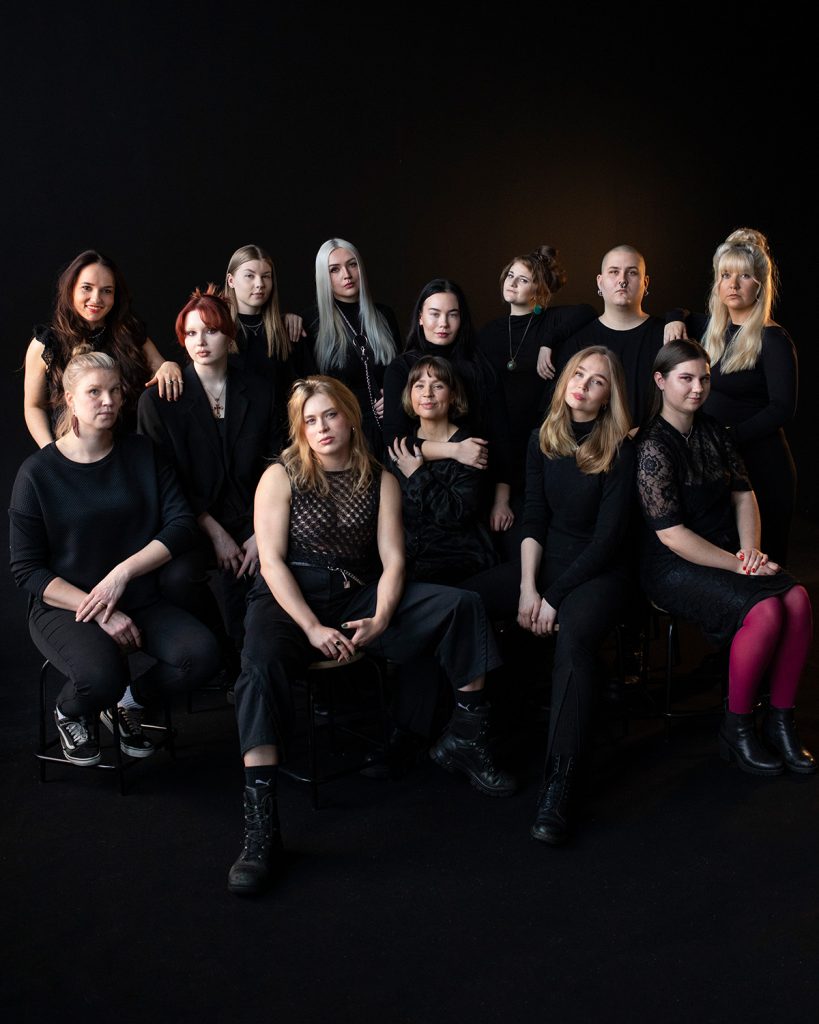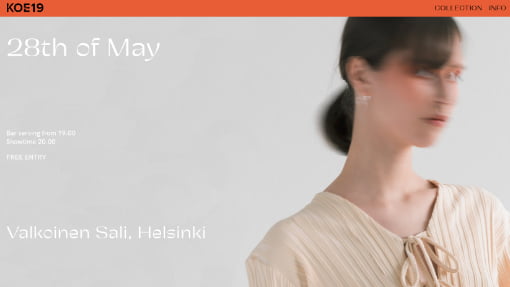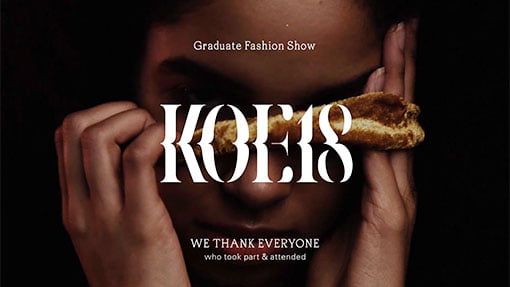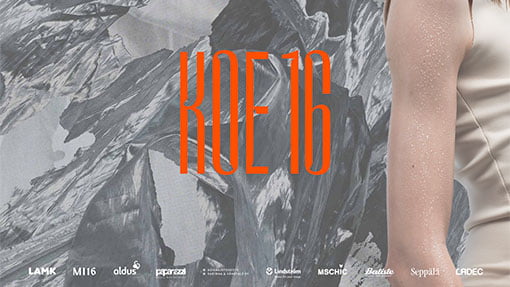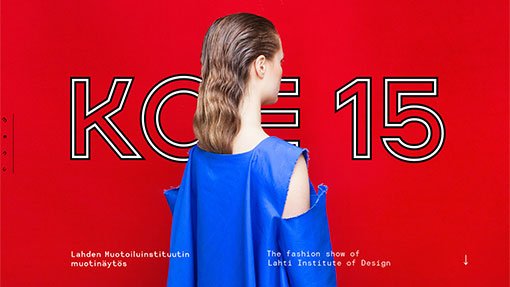KOE Fashion Show is an annual event showcasing the talent of upcoming fashion designers from LAB Institute of Design and Fine arts.
KOE22 presents the graduate collections of 12 brilliant designers with their own vision, research, and inspiration behind their designs. The collections highlight values such as sustainability and social structures. First and foremost KOE Fashion Show brings forward innovative collections and driven designers of the future. It is an inspiring fashion celebration for everyone!
KOE22 will take place at Sibeliustalo at Lahti and Valkoinen Sali at Helsinki later this spring. More information coming later.
Collections














Beda Suni
Saccharina400
Beda Suni is a graduating fashion designer who is always looking forward to finding new ways to approach materials and the design process. In her thesis collection Saccharina4000, she has studied Saccharina Latissima seaweed as a material in wearable design.
The collection is designed by honouring the material and maintaining the original stunning aesthetics of seaweed. Beda wants to make people stop by the material, cause reactions, and make people think about the reason why there are bio-based materials in the clothes instead of old familiar ones. We all need to understand that the life cycle of material is long and multi-stage. There are often many things that could be done so much safer and better. To honour our nature, in connection with nature.
In her own slow stage of mind, Beda believes that aesthetics and stories can be also part of the solution. We as designers should bravely seek new ways to think. We need to know why and for who we are designing, otherwise there is no sense in doing anything.
She often has a material-based approach to the design process. In her thesis collection, she has picked the seaweeds from the west coast of Norway. Beda found out how to make convincing textile material out of it and she is willing to keep on working with the seaweed, getting to know the material even better.
Portrait photographer: Valtteri Nevalainen
Photographer: Mária Šimová
Model: Annu / Paparazzi Model Management
MUAH: Taiga Tuulijärvi
Stylist: Emmi Rouvila, Beda Suni
Location: Spatium Toimitilat Oy
Erika Bergman
Motherland
Erika Bergman is researching Slavic national costumes and how they affect and inspire nowadays fashion. She uses the elements of the Slavic national costumes in her thesis collection. As she is using her Slavic heritage, one of the purposes of the thesis is also to inspire other designers to look into their own heritages and find acceptable ways to use them in art and design without culturally appropriating.
Since her roots are from the Slavic lands, Erika has always been inspired by the Slavic culture. The thesis collection ”MOTHERLAND” is born purely from the beauty of that culture and its complex visual details which the designer adores.
The collection is focused on East European women’s national costume and thus it is also a womenswear collection, where the purpose is to transfer the historical beauty into modern form.
By utilising historical symbolism and combining it with modern elements and materials, the collection truly represents the future brand of Erika Bergman.
Portrait photographer: Valtteri Nevalainen
Photographer: Noora Nilsén
Models: Kirsikka / Paparazzi, Piruda / AS YOU ARE Agency
MUAH: Jasmiina Walters




























Iida Lindroos
Frequencies
Iida Lindroos’ thesis studies how ultrasonic welding technology could work for different types of clothing fabrics and how it could be used in the manufacture of clothing. Ultrasonic welding melts mainly synthetic materials together and is used instead of sewing. The purpose of the research is to gather information about the technology and its functionality for fabrics, as well as to present visual ultrasonic welded solutions in her collection.
FREQUENCIES is a gender-neutral, seasonless clothing and accessories collection that combines inspiration from the street styles, an attitude of self-expression without rules, and visual effects created by ultrasonic welding. All prints and patterns in Iida’s collection are handmade using ultrasonic welding.
As a designer, Iida is experimental and always wants to try cool new ideas, still being faithful to her own style and appreciating the importance of sustainable ways to do things. She wants to design for people instead of genders and focuses on more permanent styles instead of switching trends.
Portrait photographer: Valtteri Nevalainen
Photographer: Marjaana Rantala
Model: Annu / Paparazzi Model Management
MUAH: Leena Waggoner
Location: Trio Shopping Center
Iida Suutarla
When It Rains
Iida Suutarla’s thesis studies new ways to approach the aesthetics and multifunctionality of urban rainwear. In the constantly changing climate conditions, she has taken notice of a growing demand for multifunctional elements in clothing.
In her design work, Suutarla thinks that it’s essential to offer as multifunctional collections as possible. To her, this is an important value when considering the sustainable aspects of the industry.
Suutarla also thinks that self-expression with clothing becomes very limited when the weather is challenging, which is the case for most of the year in the Northern Hemisphere. She has always felt like her favourite clothes are very separated from the pieces she could wear when it rains. Suutarla wants to challenge that thought – why can’t we have it all in one piece of clothing? She is approaching the subject through a women’s rainwear collection WHEN IT RAINS. The collection is inspired by feminine silhouettes, translucent and airy elements, and combining classic styles with little twists. The looks are designed to be mixed, matched, and layered depending on the weather.
Portrait photographer: Valtteri Nevalainen
Photographer: Katarína Cabala
Model: Isadora Paananen / Paparazzi Model Management
MUAH: Jasmiina Walters
Stylist: Iida Suutarla




























Iita Räsänen
Woolproof
Iita Räsänen’s thesis studies wool origin traceability from a clothing designer’s point of view. The objective is to find tools for a knitwear designer for sourcing and select wool that is traceable all the way to its origin. The topic is complex and viewed from multiple different perspectives.
As a designer, Räsänen finds it essential to make both ethical and ecological aspects into account without compromising the design choices. She has been passionate about knitwear from the beginning of her studies and finds knitting a very natural way to embrace both her creativity and precision.
Räsänen’s thesis collection WOOLPROOF is a seasonless knitwear collection for women. Wool yarns used in the collection are traceable throughout the supply chain, and research for the chosen yarns played an essential part in her thesis. In addition to the main material, merino wool, she has used alpaca wool, lycra, and leftover leather in the collection.
Portrait photographer: Valtteri Nevalainen
Photographer: Valtteri Haverinen
Model: Susanna Nissinen / AS YOU ARE Agency
MUAH: Jasmiina Walters’ team
Jarkko Karppinen
Rebels
Jarkko Karppinen’s thesis studies the limits of masculinity in men’s clothing. The purpose of the research is to find out why men dress the way they do, what has happened in the menswear scene in the past, and what is going to happen in it in the future. Jarkko hopes that in the future the norms and stereotypes don’t prevent people from dressing up. He thinks that in the future there is no gender in clothing.
REBELS is a menswear collection aiming to break up norms and stereotypes about how men can dress. REBELS also seeks to challenge the view of stereotypes. The visual inspiration of the collection comes from photographs of young adults in the 80s and their clothing. Some of the collection’s materials have been found in flea markets and some of them have been sponsored by Heidi Rajala and Pukuvuokraamo Kostyymi. The end result of this all is black and a mix of leather and translucent materials. Although Jarkko designs for men, the outcome is usually genderless.
As a designer, Jarkko is value-based and interested in the issues of the social culture of clothing without forgetting sustainability. For Jarkko, it feels awful to forget his values and his own style. He doesn’t want to hurt anyone when designing new collections.
Portrait photographer:Valtteri Nevalainen
Photographer: Rebekka Huomo
Models: Tom / Paparazzi Model Management, Emil / Fashion Model Agency
MUAH: Jasmiina Walters




























Katariina Rainio
Rainbow Hunt
As a designer, Katariina Rainio is playful and experimental. She thinks clothes are meant to bring a good feeling and confidence.
The thesis started out with a love for colours. In her thesis collection, Rainio wanted to implement the colour combinations she desired by using post-consumer and cutting waste. She also wanted the collection to include a traditional plaiting technique. One of the purposes of the thesis is to show that even if you use the so-called surplus, there is no need to compromise on colours or designs. An important hobby, painting, can be seen in the hand-painted western boots of the collection.
In the future, Rainio wants to be developing the apparel industry in a more environmentally friendly direction so that we can bring to market products that are sustainable and accessible to ordinary consumers.
Portrait photographer: Valtteri Nevalainen
Photographer: Lumi Heikkilä
Model: Wilma/Fashion Model Agency
MUAH: Leena Waggoner
Liisa Kantokorpi
Feminine Space
In her thesis, Liisa Kantokorpi discusses unisex clothing and its possible dimensions in the future. The thesis is based on a collaborative workshop organised as a part of the design process. The objective of the work is to understand how to approach unisex design from a feminine perspective.
In her designs, Kantokorpi utilises her expertise in artisanship. Her inspiration is drawn from dreamlike subjects that stir up feelings. Dreamlikeness manifests in the work through prints and graphic designs. These are themes Kantokorpi is planning on continuing after her graduation.
Kantokorpi’s thesis collection FEMININE SPACE combines mainly handmade knitwear and prints, in which you can see the designer’s unique and recognizable handprint. The collection is inspired by science fiction where unisex clothing has been present since the 1960s. The designer herself calls the collection a sci-fi fans interpretation of commercial unisex clothing.
Portrait photographer: Valtteri Nevalainen
Photographer: Tiiu Hyyryläinen
Models: Saara / AS YOU ARE Agency, Jian Peng / Paparazzi Model Management
MUAH: Taiga Tuulijärvi
Stylist: Liisa Kantokorpi




























Lotta Karjalainen
Samota
Lotta Karjalainen’s thesis is looking for ways to implement clothing design even more ecologically. The aim is to explore the possibility of implementing a hiking clothing collection by using zero-waste technology. Lotta is working with hiking clothes and has noticed that this technique has not been used yet. She wanted to find out if this is possible and how profitable it is.
SAMOTA is a hiking clothing collection, the aim of which is that no cutting waste is left from the production of clothing. In addition, the aim is to produce the most practical collection possible, which can be used for longer hikes as well as for everyday exercises.
As a designer, Lotta is often inspired by nature and its colours. She has a harmonious and down-to-earth style to design. Nature and its well-being are important to Lotta, so she wants to influence the problem areas of the clothing industry with her designs.
Portrait photographer: Valtteri Nevalainen
Photographer: Josefiina Turkulainen
Model: Ilona Taittonen / ONNI Agency
MUAH: Leena Waggoner
Mirka Uunimäki
Not a XXXXXXX Panacea
In her thesis, Mirka Uunimäki shows how one can use modern calculation tools as a sustainable design strategy. She combines Life Cycle Assessment (LCA) with fashion design in her collection, Not a XXXXXXX Panacea.
Panacea comes from the Greek word panakeia, meaning “all-healing”. For centuries, alchemists have worked to find a panacea, but such medicine has not been found. Thus, “panacea” is often used when criticising the idea of a total solution. In modern times, the need for a panacea comes from the desire for an easy solution for man-made climate change and material shortages. Sadly, such all-curing medicine can not be found. All we can do is create different ways to reduce our impacts and be better.
In her collection, Not a XXXXXXX Panacea, Mirka experiments on Life Cycle Assessment as a design strategy for emission minimization. As a designer, she is fascinated by understanding the whole story of the product. She wants to design its journey from fiber to its user and to the end of its life cycle. She wants to be a designer for the circular economy of tomorrow, where there is no waste, only material.
Portrait photographer: Valtteri Nevalainen
Photographer: Emil Ratilainen
Model: Kia / Fashion Model Agency
MUAH: Taiga Tuulijärvi
Stylists: Mirka Uunimäki and Helga Räty




























Nelli Löfberg
Mugworth It’s
Nelli Löfberg’s thesis studies if mugwort is suitable for new natural textile material. The ideation began when she noticed that nettle and mugwort plants look alike, and wondered if anyone had tried to make textile from mugwort. Mugwort is a weed plant that doesn’t have a good reputation because of its allergenic features. As it turns out nobody had studied its use, so Nelli took on the research and wants to restore mugwort’s reputation back to good, how it was in the old days.
Nelli uses nature as an inspiration in her designs. She focuses on different colours, patterns and shapes that nature offers up to the smallest detail. She loves to use bright colours to make her designs playful.
Her collection MUGWORTH IT’s main fabric is linen, for linen is the closest available commercial textile fibre to mugwort. A few smaller pieces of fabric are made of mugwort and linen fabric mixture, that is she made by herself. The inspiration for the collection’s cuts, lines and textures come from mugwort plant and its looks.
Portrait photographer: Valtteri Nevalainen
Photographer: Anton Kunnas
Model: Serena / Paparazzi Model Management
MUAH: Alina Koponen
Taina Eloranta
KuhaO-collection
Taina Eloranta’s thesis and KuhaO-collection examines the dyeing of vegetable tanned fish skin by utilising the mash of domestic berries generated as a by-product of juice production.
The fish skin used in the collection is self-processed. The leather is vegetable tanned rainbow trout leather, which has been fished from Lake Kitkajärvi in Kuusamo. The skins are then colored by the by-products of the berry industry. Berries used in this collection are cranberry and crowberry.
As a designer, Taina is an advocate for sustainable development. She thinks the world is full of material that can be reused to create something new.
In her collection, Taina gives new life to two different by-products in the food industry and thus expresses the idea of responsible design.
In Taina’s thesis research, she focuses on the entire life cycle of a product and how we could design clothes and accessories from the beginning to their last day. She’s always looking for new ways of finding out whether it is possible to make fully compostable products. Material-based design is natural to Taina.
The KuhaO-collections materials other than the fish skin are surplus from domestic shoe factories that would have ended up in landfills unless used in the collection.
Portrait photographer: Valtteri Nevalainen
Photographer: Nooa Haapsaari
Model: Mawahibi Tartor / Fashion Model Agency
MUAH: Leena Waggoner














Info
KOE22 Fashion Show
KOE22 is produced by the graduating Wearable Design class with the help of apparel industry professionals, fellow students, and alumni. The show is made possible with the help of companies that want to support Finnish design and share our values for a better future.
KOE22 will take place at Sibeliustalo at Lahti and Valkoinen Sali at Helsinki later this spring. More information coming later.
KOE22 team
Jarkko Karppinen, Erika Bergman, Minna Kotiranta, Liisa Kantokorpi, Iida Suutarla, Katariina Rainio, Nelli Löfberg, Lotta Karjalainen, Sini Eskelinen, Beda Suni, Iita Räsänen, Taina Eloranta, Iida Lindroos, Mirka Uunimäki, Heili Vanka and Tiina Eetteri.
Supporting team
Event coordinator: Susanna Björklund
Graphic designer: Aino Kyllönen
Photographer: Valtteri Nevalainen
Video: Aino Ahola
Digital Development: Hash Varsani | Atelier Digital
